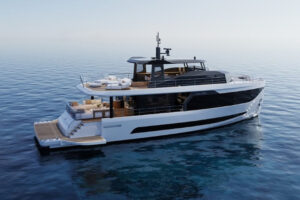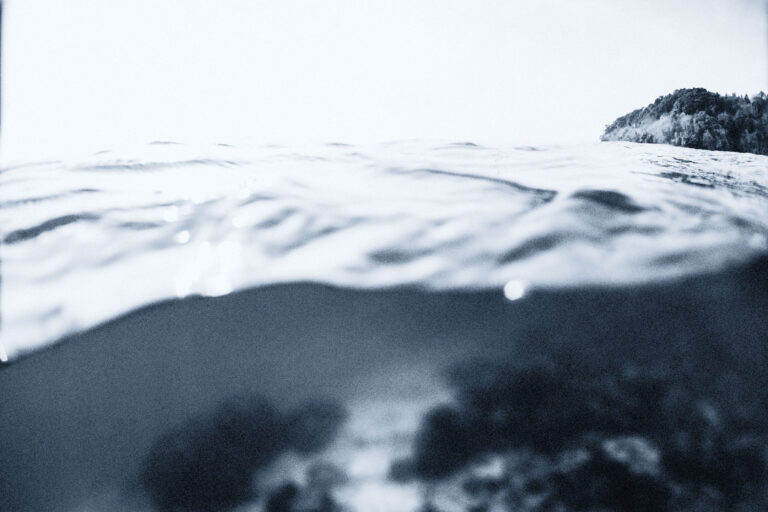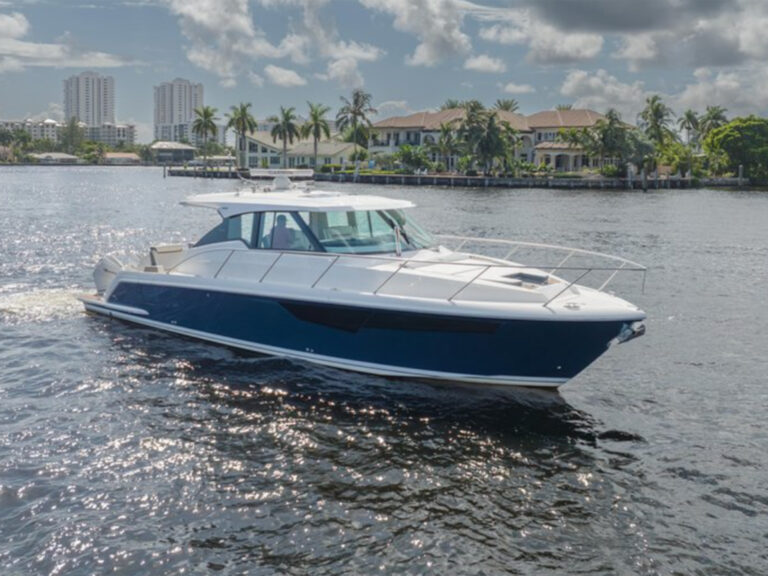Buying a production yacht that has not yet been born takes imagination. Visualizing a design based on a profile, an arrangement and a set of specifications requires an understanding eye and faith in a builder’s ability to achieve its goals. This formula proved successful in the creation of the new Symbol Yachts 64 Pilothouse.
Ed Bleckner, the owner of the first 64, has well-found faith in Symbol Yachts. In 2000 he signed up for the Symbol 62 while hull number one was still in the mold; the boat was well- received. Given the opportunity to participate in the creation of the 64, he couldn’t resist. “We enjoy the process”, Bleckner said. “Symbol and Heart Marine (Symbol’s Southeast dealer) allowed us to develop a design that suited our tastes and needs.”
Bleckner and his wife, Sondra’s, passion for boating began 11 years ago with the purchase of a 45-foot sailboat. Four years later the couple migrated to a 48-foot motoryacht.
“We were spending more and more time cruising the Bahamas”, Bleckner said, “and we eventually outgrew the 48.” The 62 had the additional legroom they were looking for and a layout that suited them. The 64 is a refinement of that theme. “We operate the boat ourselves; the 64’s design is ideal for cruising couples and is about as large a boat as we are comfortable handling without additional crew”, Bleckner said.
Moving about the boat is easy thanks to her full side decks and interior and exterior flying-bridge access. Bleckner added a spring cleat to port and starboard, which allows him more latitude in the variety of docking scenarios common in the Bahamas.
While the 64 is an extension of the 62, Symbol did more than simply stretch the tooling. To compensate for the additional buoyancy created by adding volume at the stern, the machinery and driveline were shifted aft. Fuel tanks were positioned near the center of buoyancy to minimize the effect that varying fuel loads can have on longitudinal trim.
Bleckner chose the standard power package-a pair of 800 hp Caterpillar 3406Es-and passed on the 1,000 hp Caterpillar C18s (a $103,545 upgrade). His rationale was simple: “We had a good experience with the 3406Es on the 62, and proven reliability means more to us than a few extra knots”. The 64’s slippery modified-V hull form is an excellent fit for Bahamas cruising. It is easily driven and svelte in terms of draft (4 feet, 8 inches in cruising trim). With relatively shallow deadrise aft and propeller tunnels, she can navigate skinny waters that many boats her size might avoid.
During our sea trial off Ft. Lauderdale, I recorded a maximum speed of 21.8 knots at 2250 rpm. When I eased the throttles back to 2100 rpm, the 64 yielded a comfortable 18.9 knots, and the Caterpillar electronics indicated a fuel burn of 66 gallons per hour. This is the cruising speed Bleckner finds most comfortable. I concur. For the long haul, I noted a fuel burn of 14 gallons per hour at 10 knots (1130 rpm).
The 64 accelerated evenly to maximum speed in less than 30 seconds without excessive trimming. Tabs are fitted and, when applied at cruising speed, appear to add a fraction of a knot. Still, I favor the hull’s natural trim angle, as without tabbing she will likely deliver a drier ride. Wesmar active stabilizers were fitted and are an option that makes sense for a vessel of this speed and service. Put hard over at speed, the 64 responded expeditiously without banking. On autopilot she tracked straight as an arrow. Clearly, she has plenty of rudder. Maneuverability dockside is simplified thanks to Sidepower bow- and sternthrusters.
The flying-bridge helm station and pilothouse are sensibly organized and within steps of each other. Pantograph-style doors allow easy access from the pilothouse to the side decks. The second door is a desirable option and, in my view, a necessity for cruising couples that run shorthanded.
The 64 is built under cover at Symbol’s 90,000-square-foot yard in Kaohsiung, Taiwan. This yard has been dedicated to Symbol yachts since the first was launched in 1982. Major tooling for the 64 was computer cut and finished in the United States and shipped to the yard.
The hull has a handlaid solid woven roving and mat laminate that averages three-quarters of an inch thick. A vinylester skin coat reduces the chance of blistering-a malady the builder claims it has never suffered. A network of fiberglass stringers and marine plywood bulkheads provides support.
The hull sides, decks and superstructure are cored with Divinycell foam, which is vacuum-bagged in place. The hull-deck joint is mechanically fastened and fiberglassed. The 64’s glasswork appeared carefully executed, and the bilge areas I inspected were finished. Her gelcoat exterior finish is first-rate, a reflection of the quality of her tooling.
The machinery space is accessible from the afterdeck, and access about the engines and auxiliary equipment is excellent-there is almost standing headroom. House batteries and an inverter are in a separate compartment forward. This helps reduce the length of wire runs and, in turn, weight. Piping and wiring are labeled. Curiously, aluminum tanks are an “upgrade. Bleckner stuck with the standard fiberglass tanks, which makes sense, since with proper design and construction they should last forever.
“The 64’s interior layout was really a matter of fine-tuning what had worked on the 62”, Bleckner said. For example, the flying-bridge seating area was extended aft and designed to incorporate a built-in barbecue. A refrigerator was within easy reach of the helm and companion seating. This still left room aft for a 13-foot tender.
Belowdecks, volume was added to the master stateroom as the forward machinery space bulkhead moved aft. The two guest staterooms and head forward remained the same as those on the 62. Satin-finished teak is standard, and a high-gloss finish is a $28,980 option. The Bleckners chose the satin-finished cherry interior, and fit and finish are excellent. The louvered door design is an option I recommend, as it looks great and improves ventilation.
While Symbol offers a standard arrangement plan for the 64, customers are encouraged to personalize the design. Pretty much anything goes other than moving major weights or structural bulkheads. The 64’s basic specification is used as a starting point. Heart Marine’s upgraded standard includes trendy Vimar switches and receptacles, Cantalupi lighting and an extensive entertainment package. Heart Marine provides an in-house interior designer and a generous décor allowance. Clients are also welcome to employ their own interior designers. Once a project is under way, Heart Marine’s project manager monitors the construction. This semi-custom approach is well defined in a multiple-choice-style specification.
The 64’s base price of $1,495,000 with the standard 800 hp Caterpillars does include the meat and potatoes, however, Heart Marine indicated that clients typically invest another $250,000 to $300,000 in options. Obvious choices would be a second generator, a bowthruster, stabilizers, a tender crane and the flying-bridge hardtop. If you’re headed to the Bahamas, you will want the dual-anchor system and a watermaker.
In my view, the result is a fair price for a have-it-your-way production design. If you can visualize a Symbol 64 Pilothouse in your future, figure on eight months for delivery.
Contact: Southeast: Heart Marine, (800) 457-7888; www.heartmarine.com. West Coast: Holiday Marine Sales, (800) 525-1425; www.holiday-marine.com. For more information, contact: (866) 922-4877; www.yachtingnet.com/yachting/productinfo.









